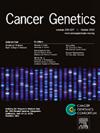基于可编程内切酶的黑色素瘤NRAS突变体ctDNA超灵敏检测
IF 2.1
4区 医学
Q4 GENETICS & HEREDITY
引用次数: 0
摘要
黑色素瘤是一种复杂且经常致命的疾病,NRAS是这种类型癌症中最常见的突变基因之一。液体活检,特别是循环肿瘤DNA (ctDNA)的检测,是一种很有前途且侵入性较小的诊断方法。本研究旨在开发一种检测黑色素瘤NRAS突变ctDNA的超灵敏检测方法。方法为了检测罕见的NRAS突变体ctDNA,我们通过筛选识别PAM序列5′-TTN-3′的CRISPR-Cas蛋白,建立了NRAS PASEA检测方法。该方法利用CRISPR-Cas蛋白在等温扩增过程中连续剪切野生型等位基因,通过Sanger测序将突变等位基因指数扩增至可检测水平。结果建立的NRAS Q61R/L/K突变检测方法在PASEA处理30 min后,可检测出突变等位基因分数(MAF)低至0.01 %的模拟ctDNA样品。值得注意的是,NRAS Q61 K突变被基于fncas12的NRAS PASEA准确地识别出来,即使核苷酸位于PAM位点“TTN”的“N”位置。该方法成功地检测了恶性黑色素瘤患者的ctDNA。15份NRAS Q61R(4/4)和NRAS Q61 K(1/1)突变的黑色素瘤血样中,所有患者(5/5)均被准确鉴定,野生型NRAS Q61患者无假阳性。结论外周血ctDNA检测对黑素瘤影像学评价困难的区域具有重要意义。我们的检测与肿瘤组织NGS的一致性为100% %,为黑色素瘤的伴随诊断和治疗效果和疾病进展的动态评估提供了新的分析策略。本文章由计算机程序翻译,如有差异,请以英文原文为准。
Ultra-sensitive detection of melanoma NRAS mutant ctDNA based on programmable endonucleases
Background
Melanoma is a complex and often fatal disease, with NRAS being one of the most frequently mutated genes in this type of cancer. Liquid biopsies, specifically tests for circulating tumor DNA (ctDNA), represent a promising and less invasive approach to diagnosis. This study aims to develop an ultra-sensitive assay for detecting melanoma NRAS mutant ctDNA.
Methods
To detect rare NRAS mutant ctDNA, we developed the NRAS PASEA assay by screening CRISPR-Cas proteins that recognize the PAM sequence 5′-TTN-3′. This method employs CRISPR-Cas proteins to continuously shear wild-type alleles during isothermal amplification, resulting in exponential amplification of mutant alleles to a detectable level by Sanger sequencing.
Results
The developed NRAS Q61R/L/K mutation detection method can detect simulated ctDNA samples with mutant allele fractions (MAF) as low as 0.01 % with 30 mins of PASEA treatment. Notably, the NRAS Q61 K mutation was accurately identified by FnCas12a-based NRAS PASEA, even with the nucleotide at the "N" position in the PAM site "TTN." The method successfully detected ctDNA in patients with malignant melanoma. All patients (5/5) from 15 melanoma blood samples with NRAS Q61R (4/4) and NRAS Q61 K (1/1) mutations were accurately identified, with no false positives among patients with wildtype NRAS Q61.
Conclusion
Detecting ctDNA from peripheral blood samples is highly significant for melanomas in areas where imaging evaluation is challenging. Our assay demonstrated 100 % consistency with tumor tissue NGS, providing a new analytical strategy for companion diagnosis and dynamic assessment of therapeutic efficacy and disease progression in melanoma.
求助全文
通过发布文献求助,成功后即可免费获取论文全文。
去求助
来源期刊

Cancer Genetics
ONCOLOGY-GENETICS & HEREDITY
CiteScore
3.20
自引率
5.30%
发文量
167
审稿时长
27 days
期刊介绍:
The aim of Cancer Genetics is to publish high quality scientific papers on the cellular, genetic and molecular aspects of cancer, including cancer predisposition and clinical diagnostic applications. Specific areas of interest include descriptions of new chromosomal, molecular or epigenetic alterations in benign and malignant diseases; novel laboratory approaches for identification and characterization of chromosomal rearrangements or genomic alterations in cancer cells; correlation of genetic changes with pathology and clinical presentation; and the molecular genetics of cancer predisposition. To reach a basic science and clinical multidisciplinary audience, we welcome original full-length articles, reviews, meeting summaries, brief reports, and letters to the editor.
 求助内容:
求助内容: 应助结果提醒方式:
应助结果提醒方式:


